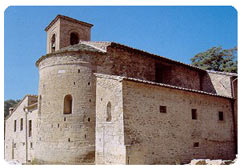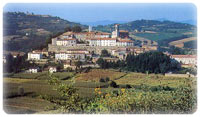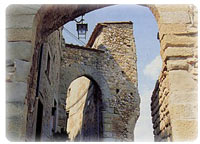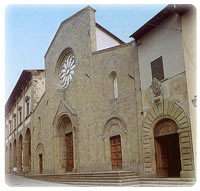Tiber ValleyThe high Tiber valley or Valtiberina, is the eastern most edge of Tuscany and gets its name from the river that crosses it throughout its length, to the border with Umbria. The Valtiberiva was border and at the same time point of encounter between different civilizations, the Umbrian and the Etruscan the Byzantine and Lombard. The bishops of Arezzo, the "signori" of Rimini and the Montefeltro, the hopes of Rome and finally the Florentines fought for centuries over these mountains and this valley.
The Roman patricians at the time of Augustus discovered the beauty of the area and built several villas. Then came the feudal lords and abbots who erected sturdy, bold castles and monasteries, followed by saints who found suitable sites to satisfy their mystic thirst. Michelangelo a native of these mountains, ad the gift of perceiving life in the core of a stone block just as Piero della Francesca in his birth place, Borgo Sansepolcro, had already understood the secret of light and space and translated it onto paintings in its variety of architectural styles in its uses and habits, in its craft products, in its own language Valtiberina reveals multiform influences coming from Romagna, Marche and Umbria, and contributing to the excentric character of the valley when compared to the Tuscan context. The traditional transit difficulty between the two slopes of the central Apennines as contributed to the relative isolation of this valley where Sansepolcro played the role of the city endowed with its own physiognomy and cultural autonomy. Intact walled towns like Anghiari or river centres like Pieve Santo Stefano, Camaldolesian abbeys and Franciscan convents, medieval country churches and castles narrate the history of this charming universe and point the stranger to most suggestive and varied itineraries. The Upper Tiber Valley is traversed in the its entire length by motorway "Tiberina3" and by motorway (E45) which connects Rome directly with northern Italy, crossing the Apennines just at the point where the Tiber rises. Numerous roads link the area with Arezzo, the Valdichiana and Casentino to the west, Romagna to the north and Montefeltro an the Adriatic coast to the east.
Caprese Michelangelo
In the Badia church, Romanesque in style
and octagonal in plan, and in the medieval church of Sant Agostino
and Palazzo Comunale priceless works of art are found.
The artistic heritage is rich and is chiefly
concentrated in the Museo Civico. Works of special importance include
some by Piero Della Francesca, the celebrated painter born in this
town early in the 15th century, in particular is polyptych of the
"Madonna Della Misericordia" and is "Resurrezione".
Buildings of outstanding note: the Romanesque Cathedral, the Loggia
Delle Laudi (16th century), the church of San Francesco (13th century). Contact us today to rent your villas in Tuscany.
|


|
Choose
your |
|
By Type |
|
By Price Range (*)
|
|
(*) |
|
In the Surroundings |
|
Arezzo Valley |
|
|



